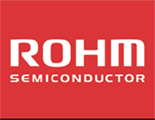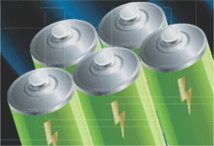Now based on Intel® Atom processor E3800 family designed for Intelligent Systems.
The Intel® AtomTM processor E3800 product family is a system-on-chip designed for intelligent systems, delivering outstanding Media/Graphics performance, ECC, while operating in an extended thermal range for industrial and automotive applications.
ROHM Co., Ltd. announced the general availability of Power Management ICs (PMICs) based on the Intel® Atom processor E3800 family.
Based on the Silvermont microarchitecture, these devices are fabricated on Intel’s industry-leading 22nm process with 3-D Tri-Gate transistors, which deliver significant improvements in performance and energy efficiency. The family offers low power consumption levels that range from 6 to 10 Watts. Intel’s newest product family is ideal for a broad range of applications such as in-vehicle infotainment systems, interactive kiosks, intelligent vending, ATMs, point-of-sale terminals as well as portable medical devices. ROHM PMICs utilize superior analog technology, ensuring outstanding performance in the most demanding applications, says the company.
ROHM PMICs utilize superior analog technology, ensuring outstanding performance in the most demanding applications. ROHM’s products have resulted in solutions that deliver breakthrough performance levels and world class power efficiency that extends to industrial thermal requirements.
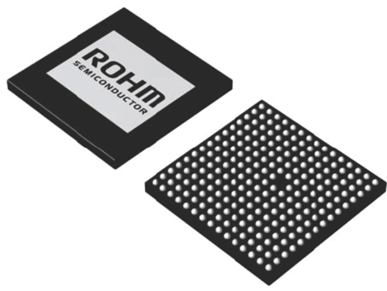 ROHM continues to strengthen its product offerings by focusing on products optimized for the industrial and commercial equipment markets,which includes car infotainment,industrial robotics, and POS systems. R O H M ’ s n e w e s t P M I C , t h e BD9596MWV, integrates an intelligent power supply core with transient load response, along with a 16channel system power supply consisting of a 2channel DC/DC controller, 3channel DC/DC regulator, 2channel IMVP7 Lite controller, 8channel LDO, and 1channel Load switch – all in a single 10mm2 package. This eliminates the need for users to develop and verify their own complex power solution that requires complicated sequences and associated circuit design, with multiple analog components, in a larger PCB area.
ROHM continues to strengthen its product offerings by focusing on products optimized for the industrial and commercial equipment markets,which includes car infotainment,industrial robotics, and POS systems. R O H M ’ s n e w e s t P M I C , t h e BD9596MWV, integrates an intelligent power supply core with transient load response, along with a 16channel system power supply consisting of a 2channel DC/DC controller, 3channel DC/DC regulator, 2channel IMVP7 Lite controller, 8channel LDO, and 1channel Load switch – all in a single 10mm2 package. This eliminates the need for users to develop and verify their own complex power solution that requires complicated sequences and associated circuit design, with multiple analog components, in a larger PCB area.
In addition, the startup sequence and clock function is built in, compatible with the Intel®AtomTMprocessor E3800 product family, (which is typically controlled by a microcontroller), reducing customer design effort significantly. ROHM PMICs also reduce mounting area by 50% and requires 40% fewer parts than comparable discrete configurations, contributing to end-product miniaturization and improved reliability. Additional features include multiple protection circuits (i.e. UVLO, TSD, SCP, OVP), a wide operating temperature range (-40°C to 95°C), and a built-in power supply that operates from 3.5V and maintains stable operation even during supply voltage drops – ensuring support even for automotive applications.
Besides the BD9596MWV, designed for industrial applications, ROHM offers the automotive-grade BD9596MWV-M.
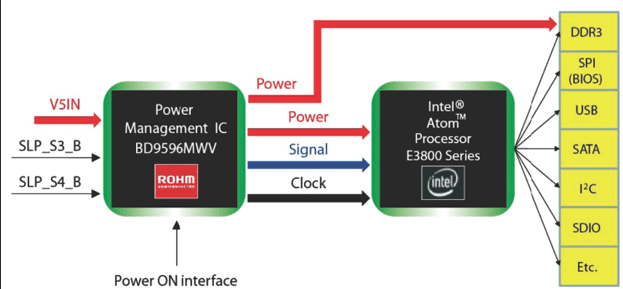
Block Diagram
Intel® AtomTM Processor E3800
The Latest Low Power Platform
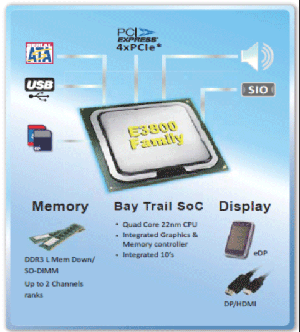 While designed to be a true test of Intel ‘s performance in the ultra mobile space , silvermont is the first true architecture update of Intel’s Atom processor since its introduction in 2008. Leveranging Intel’s first 22nm process and very low powermicro Architecture, silvermont aims squarely at the latest krait cores from Qualcomm and arm’s Cortex A15. Based on Silvermont, Intel introduces E3800 product family, a seriese of system on chip (SoC) Designed for low – power, feature –rich and highly- capable applications.
While designed to be a true test of Intel ‘s performance in the ultra mobile space , silvermont is the first true architecture update of Intel’s Atom processor since its introduction in 2008. Leveranging Intel’s first 22nm process and very low powermicro Architecture, silvermont aims squarely at the latest krait cores from Qualcomm and arm’s Cortex A15. Based on Silvermont, Intel introduces E3800 product family, a seriese of system on chip (SoC) Designed for low – power, feature –rich and highly- capable applications.
E3800 product family takes up to four Silvermont cores, and for the first time in ultra mobile intel SoC,is paired with Intel’s own graphics IP. In other words,rather than using a GPU block from imagination Technologies, E3800 product family leverages the same GPU architecture as the 3rd generation Intel® Core processors (codenamed lvy Bridge.)
Bay Trail: Not just for Atom anymore
E3800 product family combines a CPU based on Intel’s new Silvermont architecture with a GPU that is architecturally similar to (but less powerful than) the HD 4000 graphics engine integrated in the 3rd generation core processor launched in early 2012. These core components are combined with dedicated I/O blocks and media encoding and decoding to make one system-on-a-chip, which is then Manufactured on 22nm process (and the 3D tri-gate transistors) currently being used for both the 3rd and 4th Generation Intel® l core processor.Since Silvermont is the first major overhaul of atom CPU architecture since it was introduce in 2008,the main performance improvement will come from the CPU’s new out –of –order (OoO) execution engine , which allow the CPU to process different instructions as soon as resources to execute them are available. On the graphics side, E3800 product family’s GPU uses the same Intel®execution units (EUs)as the 3rd generation Intel®Core processor HD4000, which gives them support for most of the same APIs and features:Direct X11. Open GL4.0 (and Open Gl ES3.0 on mobile, provided the drivers support it),And Open CL1.2 support are all present on API side, and dual- display support for panel up to 2560*1440(or 1080p over HDMI)as well as via Intel’s Wireless Display feature will please multimonitor fans.
|
Better Performance
|
Better Power Efficienct
|
22nm Architecture
|



